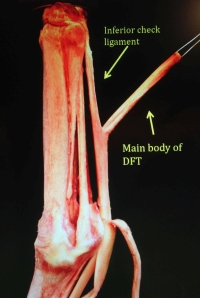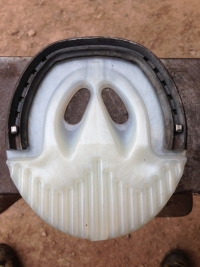The check ligaments of the horse are a bit of a tricky structure.

Photo courtesy Mitch Taylor, Kentucky Horseshoeing School
Fig. 1: The inferior check ligament is an attachment from back of the lower carpal (knee) bones to the deep flexor tendon.
A horse has two check ligaments in each front leg and one in each hind. In the front leg the proximal (uppermost) check ligament is also known as the superior check ligament, and is an attachment between the radius (upper leg above the knee) and the superficial flexor tendon. We will go with superior check ligament to simplify.
The inferior check ligament is an attachment from back of the lower carpal (knee) bones to the deep flexor tendon (Fig. 1). This ligament is also known as the distal check ligament.
The hind leg has only one, the sub tarsal (hock) check ligament. This structure is like the inferior check ligament of the front leg, connecting the lower tarsal bones to the deep flexor tendon of the hind leg.
In his book Principles of Horseshoeing, Dr. Doug Butler gives this description: “The check ligaments are really part of the tendons that attach to bone instead of muscle.” This means that while the deep and superficial flexor tendons originate in the muscle, they also attach to the bone in the upper regions of those structures via the check ligaments.
Because of the relationship and proximity to the other structures, check ligament injuries are difficult to diagnose and normally require veterinary intervention. Check ligament injuries most often involve the inferior check ligament of the front leg.
Dr. James Rooney, author of The Lame Horse, described check ligament tears as rare, except among horses pulling a load. He specifically named the Standardbred among those breeds at risk. He further explained that the action of the horse’s knee snapping into full extension while under load as a movement that could cause a check ligament injury. My belief is that this is distinguished from the knee being more fully extended before loading.

Fig. 2: Flapper pads can help a horse coming back from a check ligament injury.
It could also explain why the check ligament injury is a diagnosis less prominent than in the past. The constant evolution of racebikes make them easier to pull, and improved diagnostic equipment makes a more accurate injury diagnosis possible.
Whether less prominent or not, a check ligament problem is still a serious injury requiring prolonged rest and patience to heal. Again, veterinary intervention for diagnosis and a treatment protocol is required. Strains of this ligament are serious and tears can lead to a guarded prognosis.
Shoeing a horse that is coming back from such an injury is straight-forward. Since we already know that flapper pads help horses that are back in their knees, I think it is a sound theory to use them in this situation (Fig. 2). Flappers also reduce excessive forward slide with appropriate traction in the rear of the shoe. Plus, a square toe eases break-over. Yes, easing break-over is a recurring theme, but justifiably so and vitally important to maintaining a sound performance horse.
Deal with a mild strain or recovering from a more serious injury of these structures is not easy, but the odds are better if the horseman, veterinarian and farrier come together for a system of checks and balances.
Veteran Standardbred farrier Steve Stanley of Lexington, Ky., authors a monthly column for Hoof Beats, the official harness racing publication of the U.S. Trotting Association. The American Farriers Journal Editorial Advisory Board member offers plenty of practical advice that will be of special interest regardless of the type of horses that you work with. Click here to read more from Steve Stanley's Hoof Beats series.








Post a comment
Report Abusive Comment